"Phantom Thread" full Production Notes |
Read more at in70mm.com The 70mm Newsletter |
| Written by: Focus Features / UIP | Date: 02.02.2018 |
|
Phantom Thread |
More in 70mm reading: Film review: "Phantom Thread" in 70mm "Phantom Thread" is released in 70mm P T Anderson's "The Master" in System 65 70mm Blow Up List 2017 - by in70mm.com Panavision and the Resurrecting of Dinosaur Technology The Hateful Eight is a Wonderful Cinematic Experience for the true Cinefile Nolan's "Dunkirk" will feature over 100 minutes of IMAX material Internet link: |
Table of Contents |
|
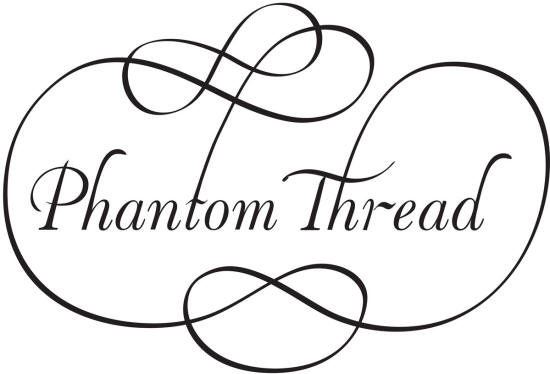 I.
Synopsis I.
SynopsisII. A Brief Introduction by Paul Thomas Anderson III. About the Production a. The Master of Us All b. The Art of Reynolds Woodcock c. The Women of Woodcock d. Casting Vicky Krieps e. The New Bloom of Couture — essay by Cassie Davies-Strodder f. Creating the Clothing g. Building the House of Woodcock: The Locations h. Post-Production: Greenwood & Tichenor IV. About the Filmmakers V. Cast and Credits |
|
Synopsis |
|
|
Set in the glamour of 1950’s post-war London, renowned
dressmaker Reynolds Woodcock (Daniel Day-Lewis) and his sister Cyril (Lesley
Manville) are at the center of British fashion, dressing royalty, movie
stars, heiresses, socialites, debutants and dames with the distinct style of
The House of Woodcock. Women come and go through Woodcock’s life, providing
the confirmed bachelor with inspiration and companionship, until he comes
across a young, strong-willed woman, Alma (Vicky Krieps), who soon becomes a
fixture in his life as his muse and lover. Once controlled and planned, he
finds his carefully tailored life disrupted by love. With his latest film,
Paul Thomas Anderson paints an illuminating portrait both of an artist on a
creative journey and the women who keep his world running. Phantom Thread is
Paul Thomas Anderson’s eighth movie, and his second collaboration with
Daniel Day-Lewis. |
|
A Brief Introduction by Paul Thomas Anderson |
|
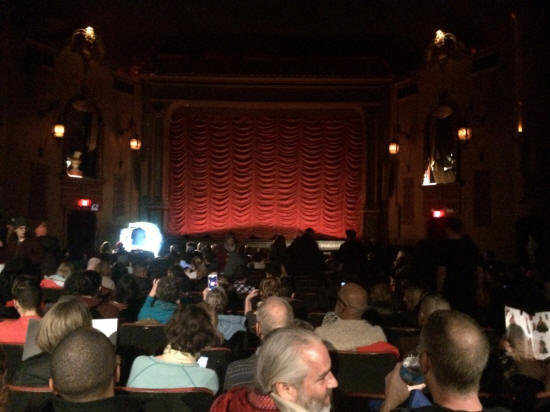 70mm
screening of "Phantom Thread" at the Music Box, Chicago, USA. Picture by
Andrew Kotwicki. 70mm
screening of "Phantom Thread" at the Music Box, Chicago, USA. Picture by
Andrew Kotwicki. London, 1955: The city is emerging from the hangover of World War II amid rations, rubble and smog. The coronation of Queen Elizabeth II has given new life to a country short on optimism. In the center of all this is Reynolds Woodcock, a man who dresses countesses, heiresses, movie stars, and grand dames. Through his creations he can make the timid feel courageous and the unattractive feel beautiful. Dealing with Mr. Woodcock, however, is sometimes akin to battling fascist forces. He's immensely talented, at the very top of his game, but he's also fussy, self-consumed and difficult. In the House of Woodcock, the business he runs with his sister Cyril, even the rules have rules. Models and clients come and go, providing inspiration and temporary companionship for Reynolds, while Cyril keeps the House running smoothly and uninterrupted. One day a young immigrant of Eastern European descent named Alma steps into Reynolds' life, disrupting his meticulously ordered world and craft with that dreaded force known as love. He is temporarily stunned and then completely consumed. Will he fight off love's powerful pull — remaining a committed artist and confirmed bachelor — or can Alma show him that life's great joys are better shared with another? And can Cyril protect her brother from Alma's good intentions, or will she come to discover that a House that doesn't change is, in fact, a dead house? Phantom Thread is a variation on the gothic romance that examines the intimacy of falling in love against a backdrop of the dangerous battlefield known as the House of Woodcock. In their attempt to capture and contain their love, Reynolds and Alma struggle to understand each other, fighting for control over instincts and impulses that only the most genuine and exciting love can yield. It features incredible performances, beautiful dresses, drunken heiresses, overbearing ghosts, and music by Radiohead's Jonny Greenwood. |
|
ABOUT THE PRODUCTION |
|
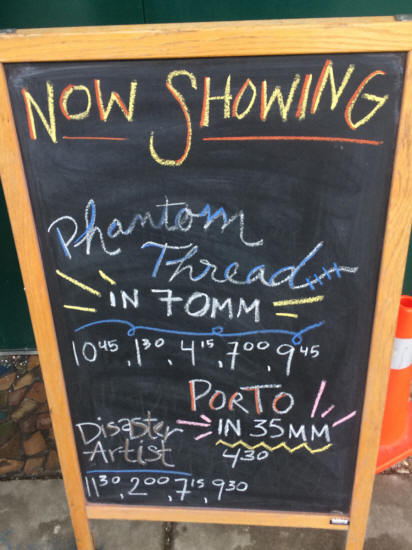 70mm
screening of "Phantom Thread" at the Music Box, Chicago, USA. Picture by
Andrew Kotwicki. 70mm
screening of "Phantom Thread" at the Music Box, Chicago, USA. Picture by
Andrew Kotwicki. The Master of Us All For his first feature to be filmed outside of the United States, Academy Award®-nominated writer-director Paul Thomas Anderson turns to the world of dressmaking in postwar London, reteaming with his There Will Be Blood star Daniel Day-Lewis for a tumultuous and elegant gothic romance that is unlike anything in the filmmaker's wildly eclectic canon. Focusing on fictional couturier Reynolds Woodcock (Day-Lewis), Phantom Thread unfurls as a love story between a master creator and his muse, whom the confirmed bachelor discovers during a weekend getaway in the English countryside. Co-starring Vicky Krieps as Alma and Lesley Manville, playing Woodcock's formidable sister Cyril, Anderson's eighth feature is awash in complex entanglements, meticulous detail and opulent atmosphere and decor. Anderson, whose most recent work includes music videos for HAIM and Radiohead as well as the 2015 music documentary Junun, had little interest in dressmaking or fashion history — until he began thinking about clothing after finishing production on his 2014 feature Inherent Vice. Some months later, as he was heading out to an event with frequent collaborator and Junun subject Jonny Greenwood, Anderson received a compliment from the musician on the cut of his suit. "He said something sarcastic to the effect of, Look at you, Beau Brummell," says Anderson. "I had to look the name up. I wanted to know more." As his interest in fashion grew, Anderson discovered the life and work of Spanish couturier Cristóbal Balenciaga (1895-1972), whose collections were internationally renowned for their iconic lacework, innovative cutting and shapely elegance. Immersing himself in Mary Blume's biography, The Master of Us All: Balenciaga, His Workrooms, His World, the writer-director became fascinated with the designer's monastic life and all-consuming approach to dressmaking, which dovetailed with Hollywood's Golden Age and the New Look in Paris, centering on Christian Dior and his reinvention of the female silhouette. With his handsome, angular features, Balenciaga also reminded Anderson of his There Will Be Blood star Daniel Day-Lewis, with whom he was eager to reunite for another project. "Daniel is so handsome, but we made a film together in which he was rather ugly in terms of character and setting," says Anderson. "I started thinking how I could make him more handsome, seeing how fashionable he was in his everyday life, and knowing well his love for clothing and grooming and making things with his hands." As a major Hollywood star who also happens to be trained shoemaker, Day-Lewis perfectly encapsulated the writer-director's burgeoning interest in Balenciaga. Anderson was also enamored with midcentury glamour and the gothic romance — specifically Hitchcock's Rebecca. He had already been thinking about a triangular dynamic for his next feature, comprising a man, a woman and his sister. "I was looking for the perfect venue for a story like this," says Anderson. "I wanted a setting that was high-class with characters immersed in finery — a world that could accommodate a gothic romance." With Day-Lewis intrigued about the project, Anderson and his star became devoted students of haute couture, learning everything they could about Balenciaga and his contemporaries, including British-born designer Charles James, who became a master cutter after relocating to Chicago at the age of 19, and Dior, who revolutionized female dressing around midcentury. They studied the artistic temperament of contemporary figures like Alexander McQueen, who early in his career wove defiant and lascivious messages into the suits and dresses he made for prominent clients including Prince Charles. "After the war, there were two parallel worlds of couture, one in Paris, which was the dominant world — the New Look — but there were plenty of other designers forging their way in London," says Day-Lewis "It felt right somehow that our work should reflect the history of England and the fabrics that came from the British Isles, which are extraordinary. The tailors and dressmakers are still making these garments, and they are beautiful. Every season when the fabrics arrive, they look at the fabrics, feel them, smell them, and make designs from them. There was something fascinating to us about the idea of England emerging from the war years, amid austerity." Narrowing their focus, the duo studied classic English tailoring, in particular the London couture houses that employed lesser-known craftsmen like Digby Morton, Peter Russell, Hardy Amies, John Cavenagh and Michael Donéllan in the years following World War II. While Paris was the epicenter of haute couture at midcentury, London was its more understated cousin, emphasizing the Savile Row tradition of bespoke tailoring. In contrast to the big houses like Dior, which employed hundreds of workers, the London houses were small, family-owned enterprises frequently run by male and female sibling duos. Creators like Amies and Morton started as apprentices and rose through the ranks to become head designers who at the height of their power dressed royals, aristocrats, socialites and luminaries of stage and screen. "In the world I was learning about, a lot of the head designers had sisters who ran the business," says Anderson. "This includes Amies in the earlier decades of the last century and Valentino and Versace in the present day." For a native Californian whose work has become synonymous with the San Fernando Valley in Los Angeles, Anderson was also keen on making a movie set in London — his first ever production outside of America. Day-Lewis for his part was eager to play another Englishman, having built his career in classic British works like My Beautiful Launderette (1986) and My Left Foot (1989), for which he won his first Oscar playing the writer and artist Christy Brown. For the last few years, Day-Lewis has played American characters, including the rapacious oilman Daniel Plainview in There Will Be Blood and the 16th President of the United States in Steven Spielberg's Lincoln, for which the actor won two more Oscars. During their extended stay in London, in which they frequently exchanged volumes on fashion and art in between visits to the Victoria and Albert Museum, where they studied vintage gowns by the likes of Balenciaga and Charles James, Anderson and Day-Lewis came to conceive the fictional couturier known as Reynolds Woodcock. |
|
The Art of Reynolds Woodcock |
|
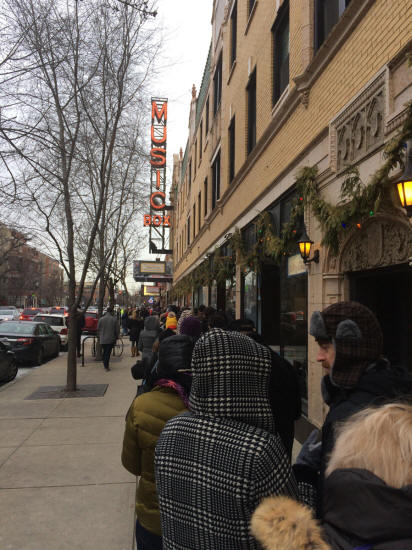 70mm
screening of "Phantom Thread" at the Music Box, Chicago, USA. Picture by
Andrew Kotwicki. 70mm
screening of "Phantom Thread" at the Music Box, Chicago, USA. Picture by
Andrew Kotwicki. Inspired by the many designers they researched, in particular the less renowned figures who flourished in London following the war, Woodcock took shape as a single bachelor who is stubborn and set in his ways — but also supremely talented and capable of turning out exquisite garments for the toast of London society. Protecting him from the outside world so he can execute his rarefied designs in peace is Reynolds' domineering sister Cyril, who manages their small Mayfair couture house in the style of real-life couturiers like Hardy Amies. In a unique collaboration that spanned months prior to production in early 2017, Anderson wrote the screenplay as Day-Lewis grew into Woodcock, sending pages to the actor as he learned how to cut, drape and sew. Unlike There Will Be Blood, which was half-completed in script form before Day-Lewis began inhabiting Daniel Plainview, the evolution of Reynolds Woodcock occurred in fits and starts over two years before Anderson completed the script and filming began. "This time around there was half a concept and a lot of thoughts and ideas that were without structure," says Anderson. "It was a back and forth process, writing for a few weeks in London, presenting Daniel with material in New York, writing a few more things, and presenting them again." Day-Lewis mastered the finer points of dressmaking during this period, studying dozens of volumes on the subject, visiting the Anna Wintour Costume Center at the Metropolitan Museum of Art in New York City, where he studied archived dresses by world-class couturiers, and learning how to sew under the instruction of Marc Happel, Director of Costumes of the New York City Ballet. "They taught him everything from basic sewing and cutting to the more elaborate process of draping and measuring," says Anderson. "At the end of his training period he proved himself by making a fantastic copy of a Balenciaga suit." What emerged from the collaboration was a character firmly in control of his environment — Reynolds Woodcock was a "style fiend" not unlike Beau Brummell, Cristóbal Balenciaga or the obsessive widower Maxim de Winter in Anderson's beloved Rebecca. "Reynolds is a man who is completely self-consumed, self-contained, self-aware and self-regimented," says Anderson. "As script and character took form, I became more and more interested in exploring what kind of man might live inside such a structure. A character requiring that level of control is ripe for being dismantled. What happens when a man like that becomes weak for the first time, or discovers that he needs somebody?" Adds Day-Lewis: "I was born in 1957, so it's the period I grew up in and had a connection to. The way in which things developed in England at the time were very specific; the restrictions were still there in many areas of society. The designers we researched somehow flourished against the current of what was happening elsewhere in the society. There was something appealing about the impossibility of setting yourself against the current of the times." In Spring 2017 the project became known as Phantom Thread, named for a predicament common among East London seamstresses in the Victorian Era who were accustomed to working long hours in miserable conditions in a manufacturing system that left them physically, emotionally and psychologically exhausted. After marathon periods of sewing magnificent dresses for royals and aristocrats, the exhausted workers found themselves, like automatons, sewing invisible threads outside the workroom — phantom threads. The title also implies a ghostly force, crafting a story from beyond the human realm in which its earthly characters remain powerless to authorial control. Do we control the art, or does the art control us? All the elements were in place for a classic gothic romance woven with precision and skill by Paul Thomas Anderson and Daniel Day-Lewis. |
|
The Women of Woodcock |
|
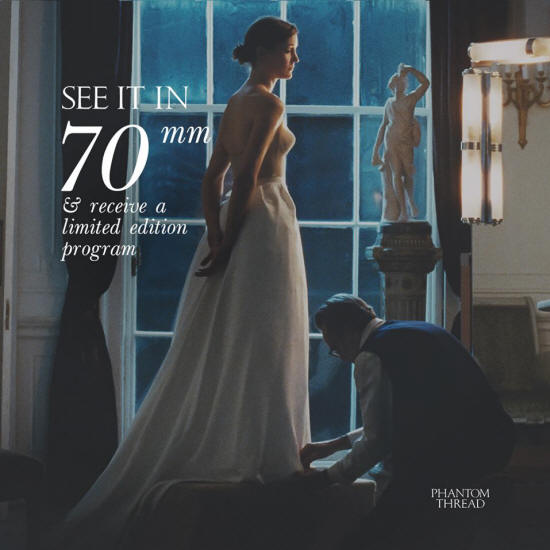 Phantom Thread began filming in London, Yorkshire and the
Cotswolds between January and April 2017. Phantom Thread began filming in London, Yorkshire and the
Cotswolds between January and April 2017. While the House of Woodcock is ostensibly controlled by one man — Reynolds Woodcock — the enterprise is kept afloat by women, in the form of its glamorous clientele, its wealthy investor Barbara Rose, and its irrepressible manager Cyril. Hovering over the House is the ghost of the Woodcocks' late mother, another formidable female presence who holds immense sway over Reynolds, appearing at his bedside in ghostly form during a fever dream in Phantom Thread's suspenseful second half. While Cyril has grown to wield immense power running the business side, Reynolds serves as its figurehead and creative force. In public, Cyril remains in Reynolds' shadow — but in private they are equals and enjoy a very strong bond. "Cyril is an exacting woman who has lived her life devoted to her brother," says Lesley Manville, who was recommended for the role by Day-Lewis, a longtime fan. A veteran of the Royal Court Theatre, the National Theatre and the Royal Shakespeare Company, Manville has also appeared in a number of works by the director Mike Leigh, including acclaimed roles in Mr. Turner, Another Year and All or Nothing. "She's an impeccably presented woman who has never wanted to marry because she's comfortable with who she is," continues Manville. "Nobody understands Reynolds like Cyril, so he's been the single most important relationship in Cyril's life. For Reynolds, she's been the constant woman in the absence of a wife. They know each other inside and out — and Cyril knows when to interact and when to leave him alone." Love enters the picture, in the form of Alma, the waitress Reynolds meets during a weekend retreat, and the House of Woodcock is shaken to its core. But where Reynolds is blindsided, Alma becomes galvanized. "It's Alma's story, this country girl and immigrant who basically takes over and comes to dominate the House of Woodcock," says longtime Paul Thomas Anderson producer JoAnne Sellar, who returns for her eighth collaboration with the filmmaker. Reynolds' close-knit relationship with Cyril becomes challenged and the dynamic of the House of Woodcock starts to shift. Cyril thinks Alma is just another muse for Reynolds, having seen many women come and go from the House of Woodcock. But a complex bond develops between the two women. Practically and pragmatically Cyril knows that the House of Woodcock needs an heir – someone to take over. Fashion is fleeting, and it belongs to the young. Cyril teaches Alma how to manage the mercurial Reynolds. Alma for her part pushes boundaries that upset the delicate balance of the House, creating the complex triangle of conflicting passions and drives that is central to the gothic romance. |
|
Casting Vicky Krieps |
|
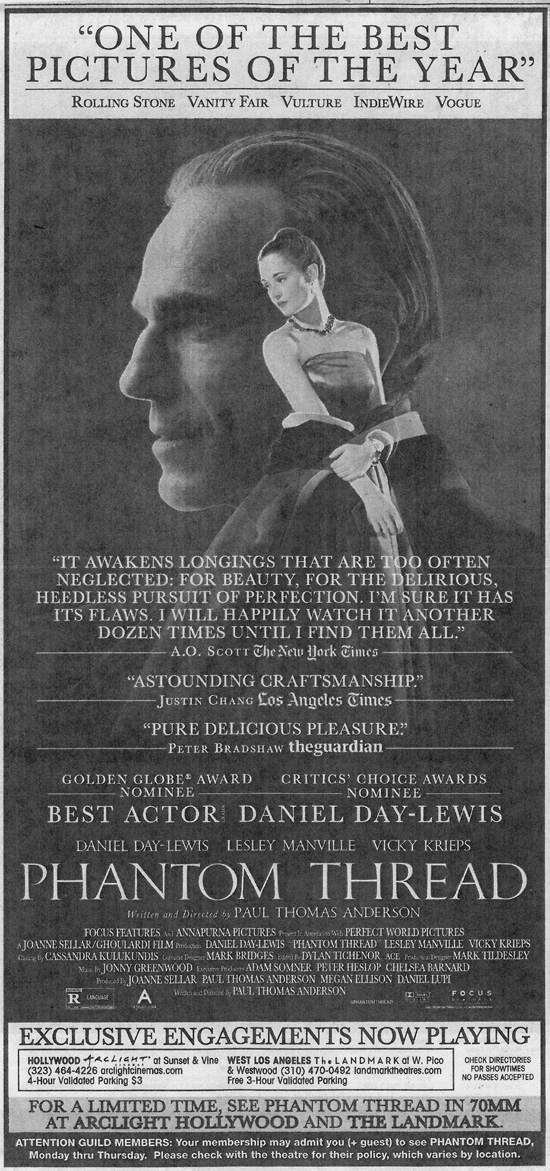 As the woman who comes between the two pillars of the House
of Woodcock, Luxembourg-born actress Vicky Krieps makes a stunning
international debut. Krieps submitted a taped audition unaware it was for a
high-profile collaboration between Anderson and Day-Lewis. The performer was
well aware of both artists' work, but had focused her career on European
fare, working predominantly in German and French productions. She didn't
hold much hope for securing the role. As the woman who comes between the two pillars of the House
of Woodcock, Luxembourg-born actress Vicky Krieps makes a stunning
international debut. Krieps submitted a taped audition unaware it was for a
high-profile collaboration between Anderson and Day-Lewis. The performer was
well aware of both artists' work, but had focused her career on European
fare, working predominantly in German and French productions. She didn't
hold much hope for securing the role.For Anderson, Krieps had everything he was looking for in Alma after he viewed her audition. "The idea was to find a woman between 25 and 33, vaguely European but hopefully Eastern European, an immigrant who made it to England during or after the war," says Anderson. "Vicky was in this movie The Chambermaid a few years back, and she was very good in it, but in that old-fashioned way she made an audition tape. It was clear from her tape that she could be a girl who worked in a teashop and someone who could wear those beautiful gowns as Reynolds' muse. In terms of her attitude and edge — that's not acting. Vicky's not afraid to stick her chin out and stand her ground." Like Krieps, Alma is an outlier who hails from a small country in Europe. But Alma is also a woman of the world, having endured the loss of her mother in the war and a painful uprooting and exodus to a foreign country. "She's a working-class girl living in a fisherman's village after moving to England for a better life," says Krieps, who has appeared in Joe Wright's Hanna and Anton Corbijn's A Most Wanted Man, among other international productions. "She comes from a place so small that you're forced to open yourself up to the world, so to speak, because it doesn't make sense to be nationalistic." Whisked off to London to become Reynolds' model and muse, falling in love along the way, Alma finds herself at home in the House of Woodcock, despite its rigid customs and social codes. "There was a strong class system In London during that time — you could feel the differences between the classes," says Krieps. "Alma being this simple girl from the continent doesn't see those differences, nor does she see herself in any kind of box. She brings with her from abroad this tendency of being the same with everyone — which puts her in the powerful position of being able to move freely between the classes in England." Alma's deep attraction to Reynolds is a mutual one, with Reynolds finding inspiration in his muse and Alma finding liberation from her previous life. But over time Alma becomes a disruptive force, testing Reynolds' power. "She has an intense feeling about things," says Krieps. "It's not quite insane, but she stands her ground very stubbornly as the affair deepens." Adds Anderson: "She's like a firecracker, disrupting Reynolds in a way that leads to the best kind of drama. I wanted to know what happens when someone like Reynolds is forced to wrestle to the ground his own peculiarities after he finds himself challenged by someone equally distinct like Alma." In Phantom Thread's delirious second half, Alma becomes the dominant force in a complex equation that envelops Cyril as much as Reynolds. "You see their dynamic shift as Alma takes charge," says Krieps. "Reynolds helps her become the woman she was all along — only stronger. The two lovers train each other in a way, like you would a muscle." Adds Anderson: "Reynolds and Alma are different people with different ambitions. Reynolds' ambition does not include sharing his life with a romantic partner whereas Alma's ambition is to convince Reynolds that he needs her. But who is the driver and who is the passenger? How they come to interchange these roles becomes the dramatic tension of the movie." In contrast to Day-Lewis' prolonged and methodical preparatory phase, Krieps had little time to prepare for the role. Following a quick meeting in London for a read-through of the script after she was offered the part, the actress arrived on set in early 2017 with no conventional rehearsal, based on Day-Lewis' wishes to forego them. Her co-star was already living and working as Reynolds Woodcock, having immersed himself in the project for many months. "Daniel did his work as he usually does — that's his secret," says Krieps. "The only thing I knew in advance was that we were effectively meeting for the first time on set — because he wasn't Daniel anymore. It was quite intense." Krieps strategy was to try and stay calm in the face of Day-Lewis' immersive preparation. "I turned myself into this blank page to play Alma," says Krieps. "I made myself as empty as I possibly could." In Yorkshire, where the weekend getaway scenes were filmed — Alma's earliest awareness of Reynolds — Krieps took long walks along the coast during breaks in filming, where she tried to talk and think as her character. "I created her biography on the spot and grew into her world," she says. "I had only a short time to imagine and conceive who Alma was." |
|
The New Bloom of Couture: An Essay by Cassie Davies-Strodder |
|
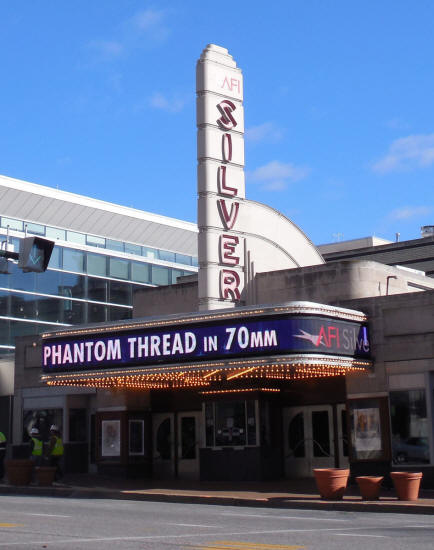 Picture
by Howard B Haas Picture
by Howard B HaasLondon at the beginning of the 1950s was the center of the British fashion industry. The city was still marked by the physical destruction of the Second World War, with rubble piles and hollowed-out buildings providing lasting scars of the conflict. The impact of clothes rationing, which finally ended in 1949, was still acutely felt as the new decade began. Fine luxury fabrics, a staple of couture clothing, were available for export but in short supply domestically, and labor shortages were a challenge for most businesses. The city was home to a small group of couturiers based in the wealthy district of Mayfair. Most occupied 18th-century townhouses in what were originally residential squares. These former domestic spaces were adopted by court dressmakers in the nineteenth century and naturally evolved into the couture houses of the twentieth century. Many of the decorative interiors of the buildings were preserved, and the marble and parquet floors, large fireplaces, decorative plasterwork, tall windows, chandeliers, and high ceilings became the dominant aesthetic of the luxury fashion trade in London. The setup of London couture houses was based on those in Paris, with design and manufacturing under one roof albeit on a much smaller scale. Clients would enter the tall, thin terrace buildings on the ground floor where the grand rooms were used as a reception space and sometimes the office of the designer. A twisting staircase, often at the center of the house, led the way to the first-floor showrooms and fitting rooms. As in Parisian houses, the workrooms were divided into tailoring and dressmaking areas. There was a great deal of variation in scale between the London couturiers, the majority of which were far smaller than their Parisian equivalents. In 1952 the two most notable houses — Norman Hartnell and Hardy Amies —designed clothes for the Queen and employed 400 and 200 workers, respectively, whereas a small house like Michael Sherard operated with a small team of 40. In contrast, a leading Paris house employed between 500 and 850 workers and showed large collections over the course of multiple seasons. In 1946, The Strand magazine documented staffing of an average London couture house. This included two female vendeuses, or saleswomen who catered for the client’s every need, taking orders, organizing fittings and advising on what to purchase. The workrooms were headed by a tailor (usually a man) or a dress fitter; under them were largely female teams of secondes, who distributed work, and the “hands,” who in turn passed on work to the “juniors” (about 40 to 60 of them). If the house was successful they might have employed two or more “house” models to show the garments. As well as the many female staff employed in the workrooms and salesrooms, women also acted as chief advisors and even business partners. These jobs were often reserved for a close family member, and several leading couturiers, including Norman Hartnell, employed their sisters in these roles. This group of distinguished London couturiers was small but diverse; each designer had his or her own distinct character and the houses were often known for their particular styles. Hartnell was known for his flamboyance, Amies, who was based in historic Saville Row, for his business-like quality. Digby Morton, who began his career at London house Lachasse, was a more quiet understated character, known for reviving the classically tailored women’s suit, making it softer and more decorative. Michael Donéllan was also known for his accomplished tailoring and became referred to as “the British Balenciaga.” Anglo-Irish Edward Molyneux had an air of Parisian glamour having originally established his first house in the French capital before founding a branch in London in the 1930s. John Cavanagh, known for his elegant pared-back evening wear and tailoring, was the dashing socialite of the group. A London couturier produced two collections per year, for Autumn/Winter and Spring/Summer. Couture garments were made with the finest fabrics and trimmings, the majority made by hand by highly skilled seamstresses before the garments were fitted bespoke to each customer. Up to three fittings were required, and it took up to four weeks to produce the finished piece. The types of clothes the couturiers made were dictated by the needs and lifestyles of the clients. In Britain, these were largely aristocratic young women and their mothers seeking clothing for the society season, a social whirl of events and gatherings traditionally centered on the activities of the royal court. A society wardrobe included debutante gowns, ball gowns, sportswear, and tailored suits for town and country. During the society season a young debutante was expected to meet her future husband, and society weddings provided another key source of commissions for the couturiers. A young woman was often introduced to a couturier by her mother and remained loyal to him or her for all major commissions, from debutante gown to wedding dress and trousseau. The “ins and outs” of the season were reported in society columns in the newspapers that often name-checked which designers the “notables” were wearing. In addition to dressing well-known society women and their daughters, publicity was also available through dressing theater stars, both on and off the stage. However, the biggest “coup” was to secure a commission from a member of the royal family, who were unofficial ambassadors for the London fashion trade, wearing British-designed and manufactured ensembles for all their major engagements. The young and beautiful Princess Margaret and the newly crowned Queen Elizabeth provided ample focus for the fashion press throughout the 1950s and they attended many fashion shows along with the Queen Mother, who was a loyal patron of the London couturier Norman Hartnell. Elizabeth chose Hartnell to design her wedding dress in 1947 and the elaborate gown for her coronation in 1953. Both events were televised and provided a huge amount of publicity internationally for the British couturiers that dressed the royal family and other notable women in attendance. The fashionable look of the 1950s was still dictated by Paris and was dominated by the hourglass shape of Christian Dior’s “New Look.” Introduced in 1947, the New Look was in fact quite retrospective, with the nipped-in corseted waist and full skirts recalling the crinoline silhouette of the 1850s. Its romanticism and femininity caught the imagination of postwar consumers who had been wearing the more masculine, utilitarian styles of the 1940s and struggling to create a fashionable, feminine image within rationing restrictions. In shocking contrast to the restrictions of rationing, New Look gowns were elaborate creations modeled from great swaths of jewel-toned silks and supported by layers and layers of silk tulle. Evening ensembles were finished with matching shoes and long gloves. Tailored suits lost their boxy shoulders in favor of newly fashionable and softer sloped shoulders and more fitted waistlines, sometimes exaggerated by padding at the hips. These were paired with matching accessories and elaborate millinery trimmed with sumptuous feathers. Another innovation of the 1950s was the cocktail hour and with it came the cocktail dress, shorter, less-formal gowns that were more playful in style. Although introduced in 1947 in Paris, the New Look style took a while to be adopted in England, where rationing remained in place until 1949. Although never a serious rival to the dominance of Parisian couture, London’s couture industry enjoyed significant success after the war, with a distinctive character all of its own. The London designers produced beautifully crafted, elegant creations. They were known for their fine craftsmanship, particularly tailoring stemming from the Savile Row tradition, and the ability to cater to the needs of the refined upper-class client for which they designed. As the events of the society season lost their formality, many of the London couturiers of the 1950s diversified into ready-to-wear and boutique clothing. As the new decade began, a number of couture houses were forced to close their doors as fashionable London shifted focus from the high-end couture of Mayfair to the irreverent youth fashions of the Kings Road and Carnaby Street. The new youth market coveted styles “bubbling up” from the streets rather than those “trickling down” from the wealthy elite and sounded the beginning of the end of the couture industry in London. Cassie Davies-Strodder is a curator of twentieth- and twenty-first-century fashion collections at the Victoria and Albert Museum. She is curator of the major V&A fashion exhibition Balenciaga: Shaping Fashion |
|
Creating the Costumes |
|
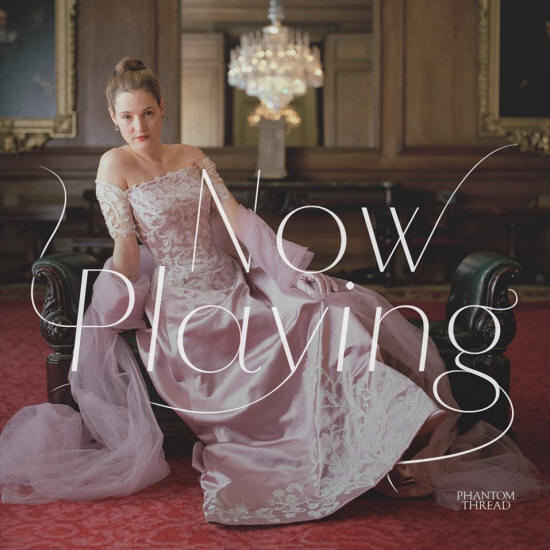 A crucial factor in bringing Phantom Thread to the screen lay
in the creation of the costumes, requiring an authenticity and
sophistication on the level of London couturiers of the era like Hardy Amies.
Anderson wasn't interested in borrowing or renting vintage apparel from
museums or costume houses. For frequent Anderson collaborator Mark Bridges
(Inherent Vice, The Master, There Will Be Blood), creating costumes from
scratch was the only solution for a story in which dressmaking is central.
"Once we decided to create original designs there was no turning back," says
Bridges. "We could only keep moving forward from that point on." A crucial factor in bringing Phantom Thread to the screen lay
in the creation of the costumes, requiring an authenticity and
sophistication on the level of London couturiers of the era like Hardy Amies.
Anderson wasn't interested in borrowing or renting vintage apparel from
museums or costume houses. For frequent Anderson collaborator Mark Bridges
(Inherent Vice, The Master, There Will Be Blood), creating costumes from
scratch was the only solution for a story in which dressmaking is central.
"Once we decided to create original designs there was no turning back," says
Bridges. "We could only keep moving forward from that point on."Bridges' mission and directive was storytelling through clothing — his garments had to reflect as much as possible the psychological makeup of the characters. The veteran costume designer, who has worked with Anderson on every feature in his canon beginning with Hard Eight in 1996, resisted focusing on a single couturier as inspiration for his creations. Instead, he researched designs from the era, creating 50 unique garments for the movie, including nine original pieces showcased in a Spring fashion show sequence. He began his research by combing through vintage editions of Vogue and Harper's Bazaar before viewing segments from the British Pathé archive on YouTube featuring newsreel footage from the era. Bridges met on several occasions with Anderson and Day-Lewis to determine the style codes of the House of Woodcock. "We spent an entire day determining the color scheme and textures of the House," says Bridges. "We settled on deep, rich hues and a lot of lace, with juxtaposed textures like velvet and satin in some garments." Bridges sourced vintage clothing from all corners of the globe, including Los Angeles, Paris, Rome, and London. But many of the garments, while glamorous and era-specific, were faded by time and wear. "We discovered early on that we would be making a lot more garments than we initially thought," Bridges says. "Silk only lasts for so long even if the garments have been well preserved. Time marches on, and moths are busy. Most of the clothes we sourced we wound up using for inspiration or understanding construction techniques. If we were duplicating a garment, we tried whenever possible to reproduce the fabrics as closely as possible to the original garment." Bridges and his team also had access to the fashion archives of the Victoria and Albert Museum, so they could examine in close detail iconic gowns from the likes of Cristóbal Balenciaga and homegrown talent like Hardy Amies. These designs were later used as inspiration for key dresses in the movie, including memorable items worn by Vicky Krieps. "Having the archive at our disposal was very helpful because we could see how lines were cut and patterns constructed," says Bridges. "It's amazing how simply conceived a lot of the garments are, including Balenciaga's embroidery, with its meticulous details." One of Bridges' team members was French cutter Cecile Van Dijk, who learned her craft at London's Central Saint Martins — where Alexander McQueen famously matriculated in the early 1990s — before going on to specialize in lace and shape cutting. Additional seamstresses and "hands" aided in the design process, with Cecile stepping in to advise Day-Lewis during scenes requiring intricate knowledge of cutting. She often arrived on set during filming to provide the actor with quick refreshers before he shot a scene. Instrumental to both the design and casting process were Joan Emily Brown and Sue Clarke, who were working as volunteers at the V&A when Anderson, Bridges and Day-Lewis were researching British couture during the summer of 2016. After helping the trio examine a Balenciaga original, Anderson discovered that both women had extensive backgrounds in fashion, with Brown having worked in two major houses on Savile Row during the 1950s, including Hardy Amies'. He hired both as creative consultants, based on their ability to verify in an instant whether a bobbin or pin was appropriate to the era. But he also gave them roles as actors, playing the crucial backroom roles of head seamstresses Nana and Biddy. Clarke had taught fashion for most of her adult life before retiring and volunteering as docent at the V&A; Brown spent decades in couture ateliers across London sewing, cutting and beading. They helped cast and crew understand workroom hierarchy, including the intricate power structure between cutters and fitters and assistants and hands. They shared minute workroom details like the mandatory white gloves worn by handlers during House fittings, and recounted stories of rigidly enforced etiquette that was the hallmark of the top Houses. "It's a very organized world to work in with an emphasis on following the rules," says Brown. "If you were the head of a workroom, you were addressed by Mr. or Mrs. along with your first name. It was all part of the etiquette of the time and you learned things quickly as you worked. There was a very disciplined way of doing things." Bridges took advantage of London's vast network of craftspeople to dress cast members both major and minor. Many have been in business for decades and include members of the aristocracy and royal family as clientele. He oversaw the fittings of suits and apparel worn by Day-Lewis and made by Savile Row tailors Anderson & Sheppard, whose firm was established in 1906 and counted the Duke of Windsor as a customer. Shoes were made at bespoke cobbler George Cleverley, who opened his namesake Mayfair boutique in 1958. Milliner Sophie Lamb — who has created masks and costume jewelry for the Royal Opera House — made the elegant hats worn in several key scenes, working with a professional dyer to get the color schemes right. Anderson and Bridges both had strong ideas about how Cyril should dress, settling on dark charcoal tones for her dresses so that Lesley Manville's English skin could sufficiently glow. "Cyril and Lesley are both a very powerful presence in the story," says Bridges. "They come across as very strong women in their own way, but also quite feminine and beautiful." Over the course of the movie, Manville wears a variety of tailored dresses and suits made by London tailor Thomas Von Nordheim, who learned his craft in the House of Lachasse, the very last of the surviving London couture houses; chief designers during Lachasse's postwar heyday included Digby Morton, Michael Donéllan and the ubiquitous Hardy Amies, all of whom were subjects of Anderson and Day-Lewis' research for Phantom Thread. Clothing designs also sought to reflect individual character arcs, including Alma's transformation from humble working-class server to London sophisticate, as she becomes model and muse to Reynolds Woodcock. "I wanted to begin her story through simple, maybe not so great-fitting clothes, garments that were either passed down from her mother or frequently mended," says Bridges. "As she gets deeper into the House of Woodcock, we see a development of shape and texture even as Alma remains herself throughout." In a strike of good fortune, Krieps showed up for her fitting appointments early in production and to Bridges' delight fit into every garment he had pulled for her. "Mark brought me a bunch of dresses sourced from museums and costume houses and wherever else he could find them," says Krieps. "I never thought of myself as a model or anyone who could wear such luxurious, refined garments, but miraculously they fit me like a glove. It was almost spooky." Adds Bridges: "Vicky had to feel the clothes and make sure they didn't come across as fake looking, since her personality comes to dominate over the course of the movie. That's something Vicky was especially great about. We see her go from rags to riches, but she maintains her individuality and independence throughout." |
|
Building the House of Woodcock: The Locations |
|
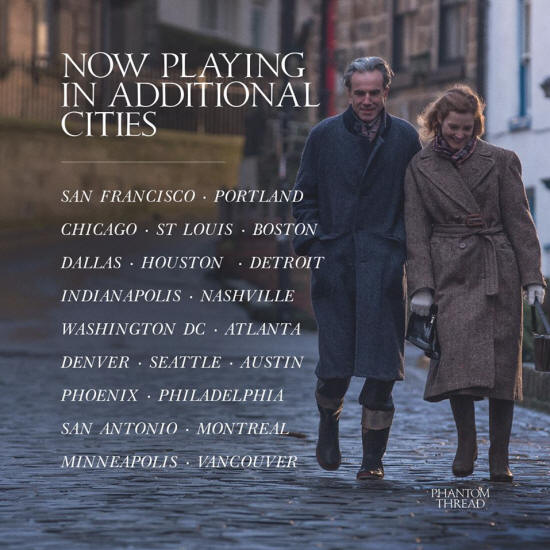 With its evocative postwar London setting and picturesque
escapes to the British countryside, Phantom Thread is steeped in romantic
atmosphere. To bring the film's two principal locations to life, Anderson
turned to British-born production designer Mark Tildesley (T2 Trainspotting,
High-Rise, Snowden), who began his career working in the costume department
of the Royal Opera House, dyeing and hand-painting ballet dresses. Tildesley
had never attempted a midcentury production. Born in London in 1963, the
designer narrowly missed the 1950s, relying on older brothers to share their
recollections and photographs of the era. With its evocative postwar London setting and picturesque
escapes to the British countryside, Phantom Thread is steeped in romantic
atmosphere. To bring the film's two principal locations to life, Anderson
turned to British-born production designer Mark Tildesley (T2 Trainspotting,
High-Rise, Snowden), who began his career working in the costume department
of the Royal Opera House, dyeing and hand-painting ballet dresses. Tildesley
had never attempted a midcentury production. Born in London in 1963, the
designer narrowly missed the 1950s, relying on older brothers to share their
recollections and photographs of the era.Working closely with Anderson and Day-Lewis early on in the production, Tildesley helped establish the psychological dimensions of Reynolds' character so they could be later reflected in the movie's sets and production design. They discussed in detail where Reynolds had been in his life and the things that surrounded him, creating an elaborate backstory for his life before establishing the House of Woodcock. "He's traveled abroad and seen lots of things, including agony and angst," says Tildesley. "This is reflected in his choice of paintings and artifacts, including the memorabilia he's collected on his journey through life. From a design standpoint, the worlds we've created are detailed reflections of Reynolds Woodcock." Tildesley and his design team made a choice early on in the production to employ authentic spaces wherever possible rather than re-create them inside a studio or soundstage. "Things need to feel grounded and real inside the world of the story," says Tildesley. "It's much easier for Paul — and for Reynolds — because their own preference as artists is for real spaces." For Reynolds this includes an elegant townhouse production found in Fitzroy Square, not far from Central London's posh Mayfair District, where he works and lives, and his brooding country home known as Owlpen, resembling Manderley in Rebecca. "Locations are always crucial to an actor's character and both Owlpen and the Fitzroy Square house are spot on in what they reflect," says Manville. "The London house is elegant and stripped back, a neutral palate punctuated with flowers and natural light. Owlpen is a classic English country house with oak paneling, a housekeeper, large comfortable sofas, and dogs. Both locations echo the precision and details of the clothing Reynolds creates." Many fashion houses in the 1950s were located in Central London, on elegant, leafy squares in the Mayfair and Fitzrovia neighborhoods, where Georgian architecture dating to the 18th century remains a prominent feature to this day. These structures, many of which are private townhomes, are notable for their high ceilings, large windows (providing ample natural light) and elegant details, including dramatic stairwells and grand salons, where luxurious socializing and fittings often took place. In Phantom Thread, the Fitzroy Square townhouse where Reynolds and Cyril live and work becomes something much more. "The House of Woodcock is a place of work but it's also a theatrical space, where clients are beguiled and made to feel glorious and wonderful as if they were on stage," says Tildesley. "Below this world — the downstairs to all the splendor upstairs — is a kind of sweatshop, where seamstresses make costumes and prepare for shows, or for private clients to come in for fittings. It's a functioning business with a kind of heightened theatricality to it, with hard work going on behind the scenes that becomes worrying, difficult, and meticulous. It's a showroom, very elegant and simple, like a ballet backdrop." Tildesley's challenge in bringing the House of Woodcock to life as a location was to focus on visual aspects, from paint color and wallpaper to lighting and fixtures, including chandeliers, mirrors, cherry wood flooring, and English carpets. "A space like the Grand Salon had to allow the colors and glory of Reynolds' creations to vibrate and exude wonder," says Tildesley. "The background had to stand out — but it couldn't interfere with the majesty of Reynolds' designs. We thought a great deal about the inherent drama of the spaces inside both the House of Woodcock and the clothing it produced — in stark contrast to Owlpen, which is dark and cluttered, a haunted world." After securing the Fitzroy Square location, a private townhome, the design team went to great lengths to transform the space into a suitable showcase for the House of Woodcock, finding challenges in everything from lighting, acoustics, restricted space and strict owners. They changed the wallpaper in several rooms, including the dining room, installing paper with a slight metallic sheen to better reflect the natural light. In one memorable breakfast scene, in which Alma, Cyril and Reynolds interact tensely during a time of day that is almost religiously sacred for the designer, the intense morning light contrasts dramatically with Reynolds' mercurial demand for silence, creating an undercurrent of psychological tension in the decor. That tension abounds in Reynolds' country home, Owlpen Manor, located outside London in the script but as a location in the Cotswolds, an area in south central England known for its posh private estates set amid forests and rolling hills. "Owlpen is a family home he's inherited, a place of dreams and memories, where he goes to relax and be himself on the weekend," says Tildesley. "He goes to the country to refresh his mind and forget the hectic quality of London." The Elizabethan-era home — also called Owlpen Manor — belongs to an aristocratic family who has modernized it over the decades, but preserved many of its architectural features. The family's son — an aspiring filmmaker and avid Paul Thomas Anderson fan — convinced his father to let the crew shoot on and around the property during a rainy and grey English winter. For the Owlpen interiors, including Reynolds' study and bedroom, Tildesley worked closely with set decorator Véronique Melery to create a brooding environment where the temperamental Reynolds retreats from stress. They focused on furnishing the environment with personal artifacts that reflected Reynolds and his taste — paintings by friends, family photographs, heirlooms and furniture at once stern and relaxing. Day-Lewis — already deep in character as Reynolds before cameras rolled — was collaborative in designing the Owlpen decor, approving and rejecting furniture and accoutrements and going so far as to demand a color change of his bedroom wall. "Daniel has very specific ideas and his process is very detailed," says Tildesley. "We spent a lot of time together in order to make it all feel authentic and true to both character and story." |
|
Post-Production: Jonny Greenwood and Dylan Tichenor |
|
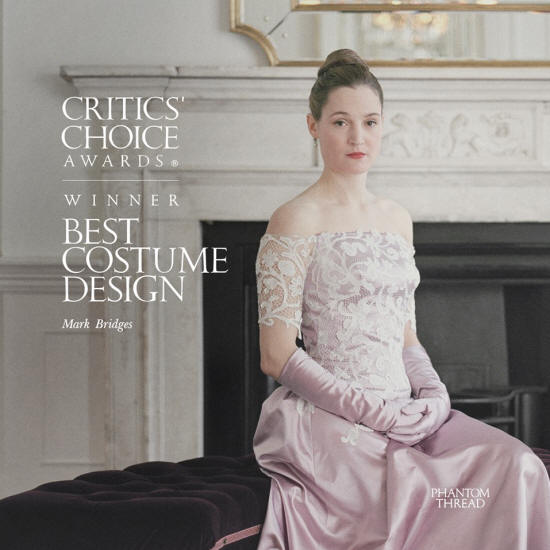 Putting the finishing touches on Phantom Thread in the
post-production phase were longtime collaborators Jonny Greenwood and Dylan
Tichenor, who return to the Anderson fold to weave together the remaining
stitches of the project in the form of its sparse, orchestral score and its
elegant, unobtrusive editing. For Greenwood, whose work typically begins
after cameras stop rolling, the score began in the production's earliest
days. "Jonny was writing music for Paul in pre-production, and even during
production,” says producer JoAnne Sellar. "During the editing phase, Paul
and Dylan were finding scenes through the music. It's an important part of
the process." Putting the finishing touches on Phantom Thread in the
post-production phase were longtime collaborators Jonny Greenwood and Dylan
Tichenor, who return to the Anderson fold to weave together the remaining
stitches of the project in the form of its sparse, orchestral score and its
elegant, unobtrusive editing. For Greenwood, whose work typically begins
after cameras stop rolling, the score began in the production's earliest
days. "Jonny was writing music for Paul in pre-production, and even during
production,” says producer JoAnne Sellar. "During the editing phase, Paul
and Dylan were finding scenes through the music. It's an important part of
the process."Greenwood, who has composed scores for There Will Be Blood, The Master and Inherent Vice, set about creating cues based on Anderson's request for music that suggested romance and darkness. Using a felt-muted piano and strings, Greenwood played Anderson his creations during various stages of production using quartets and larger string orchestras. "He wanted the music to be quite British," says Greenwood. "But we also referred to lots of Oscar Peterson and Nelson Riddle, like the strings that were written for jazz bands, but without the jazz band." Greenwood and Anderson have developed a shorthand over the years, with the composer reading scenes from the script or viewing dailies and retreating the studio to compose the cues, which Anderson uses to shape his story during various phases of production. But the music continues to shape the story during the editing process, once Tichenor received all the footage. "Jonny is extremely prolific and a genius in the way he just whips out these amazing cues," says Tichenor. "Paul and I then take those cues and put them in the movie. Often the cues are written without a specific scene or setting in mind — we just take the 20-odd cues Jonny sends us and start placing them around. Scenes come to life when you lay a good piece of music over a good sequence of film." Tichenor, who edited Boogie Nights, Magnolia and There Will Be Blood in addition to several Anderson-directed music videos, worked closely with the writer-director during and after principle photography to shape the story from hours of assembled footage. "It's a slow burn in the movie's first half, before Alma wields her power," says Tichenor. "We had much more material in an initial cut — another 45 minutes that we pared out because we had to get Alma into the House of Woodcock and start the conflict. That was our key challenge." Like Greenwood, Tichenor has worked with Anderson across multiple productions, watching the filmmaker grow and change from his earliest days on Hard Eight (on which Tichenor served as a post-production coordinator) and into Phantom Thread, with its complex mingling of competing desire among three distinct characters, including Reynolds Woodcock, who softens over the course of the film. "Over the years, up to this movie, I’ve watched Paul become more comfortable with himself as an artist," says Tichenor. "He's loosened up on the reins in many ways. I think he's more interested in seeing what's going to happen in front of the camera rather than trying to control what happens. He's always been open to happenstance and serendipity — in the editing room as well as on set I think he’s more interested in seeing what's going to happen in front of the camera rather than trying to control what happens." |
|
ABOUT THE CAST |
|
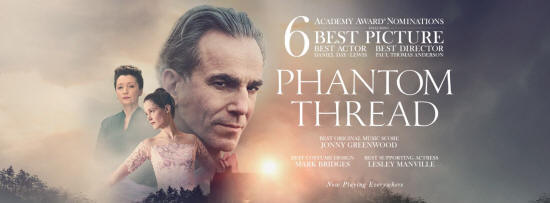 Daniel Day-Lewis (Reynolds Woodcock) Daniel Day-Lewis (Reynolds Woodcock)From his earliest roles, Academy Award® Winner Daniel Day-Lewis impressed audiences and critics alike, moving easily from a working-class punk in My Beautiful Launderette to a foppish Victorian suitor in Merchant-Ivory's A Room with a View. Together these performances earned him 1986's New York Film Critics Circle Award as Best Supporting Actor, the first of a string of accolades, including three Academy Awards® for Best Actor, four BAFTA awards for Best Actor and two Golden Globes for Best Actor. Day-Lewis also won the Screen Actors Guild Award three times, the New York Critics Award five times and three LA Critics Awards. Though Day-Lewis has continued to turn in one highly-praised performance after another, it was his role as writer, artist and cerebral palsy sufferer Christy Brown in My Left Foot for director Jim Sheridan which won him an Academy Award® for Best Actor. Day-Lewis has also been honored with Academy Award® nominations for his performances in In the Name of the Father, his second collaboration with Sheridan - the true story of a man unjustly imprisoned for 15 years - and for his portrayal of Bill, The Butcher in Martin Scorsese’s Gangs Of New York. In 2008, Day-Lewis earned another Academy Academy Award® for Best Actor as oil prospector Daniel Plainview, in Paul Thomas Anderson’s There Will Be Blood. In 2013, Day-Lewis won his third Academy Award® for Best Actor as the title character in Steven Spielberg’s Lincoln. He will next be seen in Paul Thomas Anderson’s Phantom Thread. Day-Lewis's additional film credits include the early American adventurer Hawkeye in The Last of the Mohicans, the aristocratic Newland Archer in his first collaboration with Martin Scorsese, The Age of Innocence, Philip Kaufman's film version of The Unbearable Lightness of Being, in which he won praise for his memorable performance in the leading role, and the Arthur Miller classic The Crucible, in which he portrayed Puritan John Proctor opposite Winona Ryder, directed by Nicholas Hytner. He joined up with Jim Sheridan once again for the lead role in The Boxer, and was later seen in Rebecca Miller’s powerful and poetic The Ballad of Jack And Rose. In 2009, Day-Lewis starred in Rob Marshall’s film adaptation of the Broadway Musical hit, Nine, opposite Judi Dench, Nicole Kidman, Penelope Cruz, Marion Cotillard and Kate Hudson. Born in London (but now an Irish citizen), Day-Lewis was first introduced to acting when he was at school in Kent, England. His acting debut was in Cry, The Beloved Country and his film debut was at the age of 14 in Sunday Bloody Sunday, in which he played a vandal in an uncredited role. He later applied and was accepted to the renowned Bristol Old Vic Theatre School, which he attended for three years, eventually performing at the Bristol Old Vic itself. In the 1970s and early 1980s, we worked on stage, appearing with the Bristol Old Vic Theatre Company, the Royal Shakespeare Company and the Royal National Theatre, turning in notable performances in Another Country, Dracula, Futurists and Hamlet, in which he played the title role. |
|
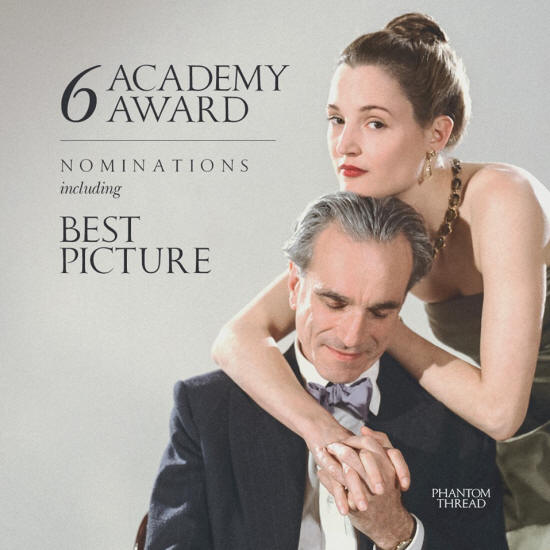 Vicky Krieps (Alma) Vicky Krieps (Alma)Vicky Krieps came into the international spotlight with her supporting role in Eileen Byrne's La Nuit Passée, for which she was awarded Best Youngster at the Busho Festival Budapest in 2008. She has since gone on to appear in theatre and film productions, working with directors including Joe Wright, Lars Kraume, Andy Bausch and Julien Temple. In 2011, she appeared in Roland Emmerich's political thriller Anonymous. In 2012, she earned the Prix du Jeune Espoir (Best Young Hopeful) in Luxembourg. Her latest film productions include Philippe Claudel's Avant l'Hiver, Detlev Buck's Vermessung der Welt, Anton Corbijn's A Most Wanted Man, and Georg Maas' Zwei Leben, which was the German candidate for Best Foreign Film at the Academy Awards. She studied at the Zurich University of Arts and was part of the ensemble at the "Schauspielhaus" Zurich for many years. She speaks German, French, English and Luxembourgish. Lesley Manville (Cyril) In film, Lesley has worked extensively with Mike Leigh, most notably in Another Year (2010), for which she received the NBR award for Best Actress, British Actress of the Year at the London Critics Circle Awards as well as a BAFTA nomination for the role. In 2002, Leigh and Manville worked together on All or Nothing, for which she also won British Actress of the Year at the London Critics Circle Awards. Other films include Maleficent (2014), Mr. Turner (2014), Topsy Turvy (1999) and Secrets and Lies (1996). Lesley’s television credits include the Netflix/BBC series "River" (2015) for which she received a BAFTA-TV award nomination for Best Supporting Actress, The Go-Between (2015) and the classic BBC series "Cranford" (2007) and "North and South" (2004). Lesley received a BAFTA-TV award nomination for Female Performance in a Comedy for the title role in the BBC’s critically acclaimed series "Mum." Series 2 airs in 2017. Following this she will also return to her role in the highly anticipated second series of "Harlots" on Hulu. Set in the world of London’s 18th- century sex trade, Manley stars alongside Samantha Morton and Jessica Brown Findlay. Lesley has had an illustrious stage career to date, working extensively at the Royal Court, Royal Shakespeare Company, Old Vic and National Theatre. In 2014 Lesley won both the Olivier Award and Critics’ Circle Best Actress Award for her role in Ghosts at The Almeida, London and the Brooklyn Academy of Music in New York. Her performance received stellar reviews. Early next year Lesley will return to the stage to revive her role as Mary Tyrone in Long Days Journey Into Night, alongside Jeremy Irons, at Wyndham's Theatre in London, before the production heads to New York and Los Angeles. Lesley was made an OBE in the 2015 Queens Birthday Honours List. |
|
ABOUT THE FILMMAKERS |
|
|
Paul Thomas Anderson (Writer, Director, Producer) Paul Thomas Anderson wrote and directed Hard Eight (1996), Boogie Nights (1997), Magnolia (1999), Punch-Drunk Love (2002), There Will Be Blood (2007), The Master (2012), Inherent Vice (2014), and Junun (2015). Mark Bridges (Costume Designer) Born and raised in Niagara Falls, New York, Mark received a Bachelor of Arts degree in Theater Arts from Stony Brook University. He then worked at the legendary Barbara Matera Costumes in New York City as a shopper for a wide range of Broadway, dance and film projects. Following his time at Matera's, Mark studied for three years at New York University's Tisch School of the Arts, and received a Master of Fine Arts degree in costume design. After New York University, Mark began working in film whenever possible and was Assistant Costume designer on the film In the Spirit (1990) with Marlo Thomas and Elaine May, and design assistant to Colleen Atwood on the Jonathon Demme film Married to the Mob (1988). In 1988, Mark worked as design assistant for Richard Hornung on the film Miller's Crossing (1990), a collaboration that would continue for eight more films. In 1989, Mark relocated to Los Angeles to be Assistant Costume Designer to Richard Hornung on The Grifters (1990), Barton Fink (1991), Doc Hollywood (1991), Hero (1992), Dave (1993), The Hudsucker Proxy (1994), Natural Born Killers (1994), and Nixon (1995). In 1995, Mark began his costume design collaboration with Paul Thomas Anderson, designing Hard Eight (a.k.a. Sydney, 1996). Their next work together was on the critically acclaimed Boogie Nights (1997), followed by Magnolia (1999), Punch-Drunk Love (2002) and There Will Be Blood (2008) starring Daniel Day Lewis. Mark also designed The Master (2012) starring Joaquin Phoenix, Phillip Seymour Hoffman and Amy Adams. Mark's seventh collaboration with Paul Thomas Anderson was designing Anderson's Inherent Vice (2014), starring Joaquin Phoenix, which resulted in Mark receiving an Oscar nomination for Best Costume Design. In 2012, Mark won an Academy Award, a BAFTA award and the People’s Choice award for his costume design for the Best Picture Academy Award winner The Artist (2011), directed by Michel Hazanavicius. Other costume design work includes Fifty Shades of Grey (2015) for director Sam Taylor-Johnson, starring Dakota Johnson and Jamie Dornan; The Fighter for director David O. Russell, starring Mark Wahlberg, Christian Bale and Amy Adams; Greenberg, starring Ben Stiller, for director Noah Baumbach; Yes Man (2008), starring Jim Carrey; Fur: An Imaginary Portrait of Diane Arbus (2006) starring Nicole Kidman and Robert Downey Jr.; I Heart Huckabees (2004) with Dustin Hoffman and Isabel Huppert; The Italian Job (2003), starring Mark Wahlberg and Charlize Theron; 8 Mile (2002) starring Eminem; Blow (2001) starring Johnny Depp; Blast From the Past (1999) and Can't Hardly Wait (1998). Mark also designed Captain Phillips (2013) and Jason Bourne (2016) for director Paul Greengrass. Bridges' costume designs were part of the Hollywood Costume exhibition at the Victoria and Albert museum in London England in the Fall of 2012. Mark’s designs were also part of the 1998 Biennale di Firenze Fashion/Cinema exhibit and The Academy of Motion Picture Arts and Sciences exhibit Fifty Designers, Fifty Costumes: Concept to Character shown in Los Angeles and Tokyo in 2002. Mark was also one of the film artists included in On Otto, an installation at the Fondazione Prada in Milan, summer 2007. Bridges' design work has appeared in publications as diverse as Australian Harper's Bazaar, Vogue, The New York Post, The Hollywood Reporter, and the books Dressing in the Dark by Marion Maneker, and Dressed: 100 Years of Cinema Costume by Deborah Nadoolman Landis. Mark’s career and design work is included in the new Costume Design book in the Film Craft series by Deborah Nadoolman Landis (2012). Jonny Greenwood (Composer) Jonny Greenwood is a member of the acclaimed alternative rock band Radiohead. Greenwood serves mainly as lead guitarist and keyboard player but also plays viola, xylophone, glockenspiel, ondes martenot, banjo, harmonica and drums. He also works on the electronic side of Radiohead, working on computer-generated sounds and sampling. His film score credits include Paul Thomas Anderson’s Inherent Vice, The Master, and There Will Be Blood, Lynne Ramsay’s We Need to Talk About Kevin, and Tran Anh Hung’s Norwegian Wood. In addition, he has served as the Composer in Residence for the BBC Concert Orchestra. |
|
|
Dylan Tichenor, A.C.E. (Editor) Dylan Tichenor got his start in the craft of editing with editor Geraldine Peroni, who brought him on as apprentice editor on Robert Altman’s The Player. Continuing this collaboration he went on to be assistant editor on Short Cuts, Prêt-à-Porter [Ready to Wear], associate editor on Alan Rudolph's Mrs. Parker and the Vicious Circle, then technical coordinator on Altman's Kansas City, and finally as co-editor on the documentary Jazz '34, for which he earned an Emmy nomination. Mr. Tichenor subsequently entered an ongoing collaboration with writer/director Paul Thomas Anderson, beginning as post-production supervisor on Sydney [Hard Eight], and then editing the award-winning features Boogie Nights, Magnolia and There Will Be Blood, for which he was nominated for an Academy Award. Mr. Tichenor's credits as editor also include Hurlyburly (Tony Drazan), Unbreakable (M. Night Shyamalan), The Royal Tenenbaums (Wes Anderson), Brokeback Mountain (Ang Lee), The Assassination of Jesse James by the Coward Robert Ford (Andrew Dominik), Doubt (John Patrick Shanley), Whip It (Drew Barrymore), The Town (Ben Affleck), Lawless (John Hillcoat), and Zero Dark Thirty (Kathryn Bigelow) which earned him a second Academy nomination. His latest projects include Child 44 (Daniel Espinosa), Triple 9 (John Hillcoat), American Made (Doug Liman), and Stronger (David Gordon Green). Mark Tildesley (Production Designer) Mark Tildesley is an award winning production designer from Britain. He received a Primetime Emmy for “Outstanding Art Direction for Variety or Nonfiction Programming” of the London 2012 Olympic Opening Ceremony: Isles of Wonder in 2012. In 2006, Tildesley was nominated for the Art Directors Guild Award in “Excellence in Production Design – Contemporary Film” for The Constant Gardener, directed by Fernando Meirelles. Tildesley frequently collaborates with Oscar winning director Danny Boyle and auteur filmmaker Michael Winterbottom. His career highlights include: I Want You (1998), Wonderland (1999), With or Without You (1999), The Claim (2000), 28 Days Later… (2002), Code 46 (2003), Millions (2004), Sunshine (2007), The Killer Inside Me (2010), David Gordon Green’s Your Highness (2011), Trance (2013), Bill Condon’s The Fifth Estate (2013), Ron Howard’s In the Heart of the Sea (2015), Oliver Stone’s Snowden (2016), and T2 Trainspotting (2017). JoAnne Sellar (Producer) JoAnne Sellar has previously paired with Paul Thomas Anderson on Boogie Nights, nominated for three Oscars; Magnolia, nominated for three Oscars; Punch-Drunk Love; There Will Be Blood, which was nominated for eight Oscars, including Best Picture and Best Actor (Daniel Day-Lewis; winner) and Best Cinematography (Robert Elswit); The Master, which was nominated for three Oscars, including Best Actor (Joaquin Phoenix), Best Supporting Actor (Philip Seymour Hoffman) and Best Supporting Actress (Amy Adams); and Inherent Vice, nominated for two Oscars, including Best Adapted Screenplay (Paul Thomas Anderson) and Best Costume Design (Mark Bridges). In addition, Sellar produced Jennifer Jason Leigh and Alan Cumming’s critically acclaimed The Anniversary Party. Her repertoire of feature-film producing credits began with the sci-fi thriller Hardware. She went on to produce such films as Richard Stanley’s Dust Devil, George Sluizer’s Dark Blood, and Clive Barker’s Lord of Illusions. Prior to segueing to film, Sellar had a successful career producing music videos for the likes of U2, Elvis Costello and Iggy Pop. Her diverse experience also extends into television, where she co-produced “Red, Hot, & Blue,” a worldwide tribute to Cole Porter benefiting AIDS research. Her career began in the early `80s, programming a repertory cinema in London called The Scala, which won acclaim for its diverse, original and alternative film selections. Megan Ellison (Producer) Megan Ellison is the founder and CEO of Annapurna, a studio that focuses on creating sophisticated, high quality content. Ellison’s vision has been to produce critically and commercially conscious projects, which appeal to a diverse audience. Annapurna’s foundation reflects Ellison’s belief of allowing filmmakers and artists to create story content of all genres and mediums while preserving their authenticity. In the past year, Ellison has evolved Annapurna into a studio with its own marketing and distribution arm, and has also created new television and gaming divisions, Annapurna Television and Annapurna Interactive, respectively. In 2017, Ellison produced Kathryn Bigelow’s Detroit, which premiered to critical acclaim and is also a producer on Phantom Thread, and an executive producer on Alexander Payne’s Downsizing. Annapurna is currently in post-production on Richard Linklater’s highly-anticipated adaptation of Maria Semple’s novel, Where’d You Go, Bernadette, starring Cate Blanchett, Billy Crudup, and Kristin Wiig, and Jacques Audiard’s first English language film, The Sisters Brothers, starring Riz Ahmed, both of which the company will release in 2018. The company is also in production on Adam McKay’s untitled Dick Cheney biopic, starring Christian Bale as the infamous vice president, and on If Beale Street Could Talk with recent Academy Award-winner Barry Jenkins writing and directing the James Baldwin adaptation. Since 2012, Annapurna’s projects have earned thirty-two Academy Award nominations, having been nominated in each year since its founding, and Ellison is one of only four honorees ever to receive two Best Picture nominations in the same year. Annapurna’s three Best Picture-nominated films include David O. Russell’s American Hustle, Spike Jonze’s Her, and Kathryn Bigelow’s Zero Dark Thirty. Daniel Lupi (Producer) Daniel Lupi most recently executive produced the upcoming Steven Spielberg film Ready Player One. He has also executive produced Spielberg’s Bridge of Spies, the Oscar - and BAFTA - nominated biographical drama Lincoln, and Catch Me If You Can. He executive produced Spike Jonze’s critically acclaimed film Her. Daniel has collaborated with Paul Thomas Anderson on all eight of his narrative feature films, including Inherent Vice, The Master, There Will Be Blood, which received a Best Picture Oscar nomination, Punch-Drunk Love, Magnolia, Boogie Nights, and Hard Eight. |
|
|
A FOCUS FEATURES |
|
| Go: back - top - back issues - news index Updated 22-01-25 |
